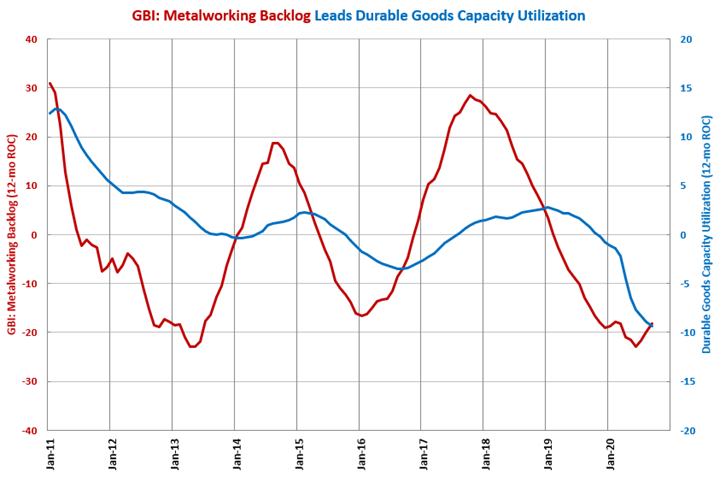Capacity Utilization Contraction Slowing
The rate of contraction in durable goods capacity utilization should bottom out in the 4th quarter of 2020, according to the Gardner Business Index.
In September, durable goods capacity utilization was 69.4%, which was the third month in a row that the rate of capacity utilization was at least 69.4%. Compared with one year ago, capacity utilization contracted 7.5%, which was the fifth straight month that the month-over-month rate of change contracted at a slower rate and the slowest rate of contraction since February.
The annual change in durable goods capacity utilization contracted at an accelerating rate for the 11th month in a row, falling to -9.3% from -8.9%. September was the fastest rate of annual contraction since March 2010. As the annual rate of change tends to lead capital equipment consumption by seven-to-10 months, capacity utilization is signaling accelerating contraction in capital equipment spending through at least the fourth quarter of 2020 and possibly into the first quarter of 2021.
The GBI: Metalworking backlog index tends to lead the annual rate of change in capacity utilization by seven to 10 months. In September, the backlog index grew 3.6% compared with one year ago. This was the first month of month-over-month growth since October 2018. The annual rate of contraction in the backlog index appeared to reach a bottom in June. The Backlog index is indicating that the accelerating contraction in durable goods capacity utilization will likely end during the 4th quarter of 2020.

Accelerating Growth:
Decelerating Growth:
Accelerating Contraction: aerospace, construction materials, durable goods, electronics/computers, forming/fabricating (non-auto), furniture, machinery/equipment, petrochemical processors, primary metals, printing, textiles/clothing/leather goods, wood/paper products
Decelerating Contraction: automotive, custom processors, food/beverage processing, plastics/rubber products




.JPG;width=70;height=70;mode=crop)
